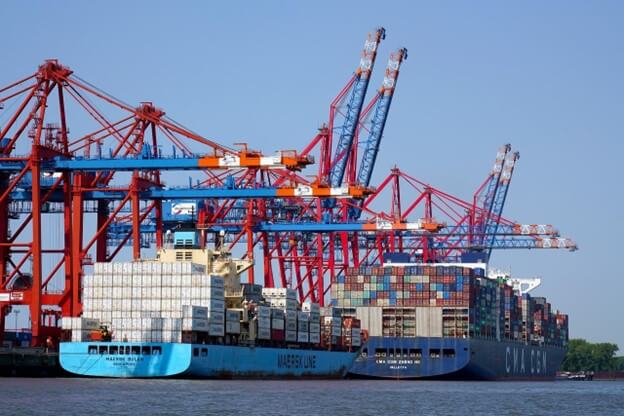
In today’s globalized and interconnected world, businesses rely heavily on their supply chains to meet their production and customer needs. However, depending on a single supplier or location can expose your business to various risks and disruptions such as natural disasters, political instability, economic fluctuations, or supply shortages.
According to a report done by the New York Times, since Covid-9 shutdowns and reopening, companies across the world have been on a mission to diversify their supply chains. Companies realized that during the pandemic that they couldn’t rely on a single supplier, port, country or region and therefore made investments to diversify their supplier base.
The rise of e-commerce has revolutionized the way we shop and do business. With online sales projected to reach $6.5 trillion by 2023, e-commerce has become a key driver of global trade. As an e-commerce seller, you face unique challenges in managing your supply chain.
One of the most critical factors in your success is diversifying your supply chain. Diversifying your supply chain means identifying and engaging with multiple suppliers or locations that can provide you with the same or similar products, materials or services. By doing so, you can spread the risk and reduce your vulnerability to unexpected events or changes in the market.
In this article, we will explore why diversification is crucial for e-commerce sellers and how you can implement it.
Reasons why you Need to Diversify your Supply Chain
- Mitigating riskRisks are an inherent part of any business, but e-commerce sellers face unique challenges. When you rely on a single supplier or location, you are putting all your eggs in one basket. This leaves you vulnerable to disruptions like natural disasters, geopolitical instability, trade disputes, and pandemics. For example, the COVID 19 has disrupted supply chains worldwide, causing delays and shortages.Diversifying your supply chain helps mitigate these risks by spreading them across multiple suppliers and location. If one supplier or location is affected, you can still maintain business continuity by sourcing from other supplier. This gives you more resilience and flexibility in dealing with disruptions.
- Ensuring business continuityIn the fast -paced world of e-commerce, disruptions can be costly. A delayed shipment or out-of-stock can result in lost sales and dissatisfied customers. When you diversify your supply chain you can ensure business continuity by having multiple sources for your products.For example, let’s say you sell a popular item that’s sourced from a single supplier. If that supplier experiences a delay or runs-out of stock, you will be left with a backlog of orders and unhappy customers.On The other hand, if you had multiple suppliers for that item, you could quickly shift to another source and fulfill orders without delay.
- Cost savingsManaging costs is a critical factor in the success of any business. By diversifying your supply chain, you can achieve cost savings in several ways. First, you can negotiate better pricing by having more leverage with multiple suppliers.Second, you can access new suppliers who may offer lower prices or even better terms. Finally you can reduce shipping costs by sourcing from suppliers closer to your customers.
- InnovationInnovation is essential for e-commerce sellers who want to stay competitive. Diversifying your supply chain can help you tap into new markets, technologies and ideas that can drive growth. For example, you may find new suppliers who offer unique products or services that differentiates you from your competitors.Innovation can also come from collaborating with your suppliers. By working closely with them, you can develop new products, improve existing ones, and optimize your supply chain. This can result in cost savings, increased efficiency and better customer satisfaction.
- Competitive advantageIn today’s hyper-competitive e-commerce market, having a competitive advantage is crucial. By diversifying your supply chain, you can be more agile and responsive to changing market conditions and customer demands. For example, if a competitor is out of stock on a popular item, you can quickly source it from a different supplier and capture those sales.Diversification can also help you differentiate your brand. By sourcing from suppliers who share your values and ethics, you can build a reputation for sustainability, social responsibility and quality. This can attract customers who are willing to pay a premium for products that align with their values.
- Regulatory complianceRegulatory compliance is an essential aspect of e-commerce. You must comply with local regulations, labor laws and environmental standards to avoid legal and reputational risks. Diversifying your supply chain can help you comply with these regulations by sourcing from suppliers who meet the required standards.For example, if you source products from overseas, you must comply with customs regulations and import laws.
- Increase resilienceDiversifying your supply chain can also increase your business’s resilience and adaptability to changes in the market, competition, or customer demand. Having multiple suppliers or locations can give you more flexibility to adjust your production delivery, or pricing strategies.
- Enhancing reputation and sustainabilityDiversifying your supply chain can also help you meet social and environmental expectations and regulations. By sourcing from a variety of suppliers or locations, you can ensure ethical labor practices, environmental stewardship, or local community engagement, which can enhance your reputation and sustainability.
Diversifying your supply chain can also present several challenges that you need to be aware of such as:
- Increased complexityManaging multiple suppliers or locations can be more complex and time-consuming than relying on a single source. You need to ensure that each supplier or location meets your quality, cost, delivery and compliance requirements and coordinate their activities effectively.
- Higher costsDiversifying your supply chain may involve higher costs, such as transportation, warehousing, inspection, or communication. Moreover, you may need to invest in new technologies, systems or personnel to manage and integrate the different sources effectively.
- Quality variabilityDifferent suppliers or locations may have different quality standards, processes or certifications, which can affect the consistency and reliability of your products or services. You need to ensure that each source meets your quality criteria and monitor their performance regularly.
- Supply chain disruptionDiversifying your supply chain does not guarantee immunity from supply chain disruptions, such as natural disasters, trade restrictions, or geopolitical conflicts. In fact, having multiple sources may increase the likelihood of disruption and make it harder to respond quickly.
- Cultural and language barrierWorking with suppliers or locations from different cultures or languages can pose communication, negotiations, or expectation challenges. You need to develop cultural awareness and language proficiency and establish clear and respectful communication channels.
In Conclusion
Diversifying your supply chain can offer significant advantages that can help you mitigate risk and enhance resilience. By identifying and engaging with multiple suppliers or locations, you can spread the risk, improve quality and innovation, enhance reputation and sustainability, and expand opportunities.
Therefore, it is essential to evaluate your supply chain and identify potential areas for diversification and implement a plan that aligns with your business objectives and values.




